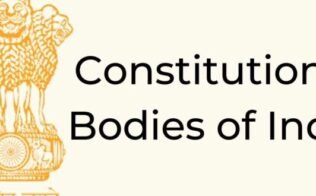Are you here to know the basic structure of Indian Constituation or Basic Structure Doctrine Indian Constituation? If yes then, you are at the Right Place. In this article, we will see the Basic Structure Doctrine in depth.
A progressive text, the Indian Constitution can be modified whenever necessary to meet the evolving requirements of the country. Parliament has the authority to amend the Constitution under Article 368 of the Constitution. Additionally, the article explains in great detail how amendments can be made.
It is just a Judicial Review notion that the Constitution of India contains some basic aspects that cannot be amended or destroyed by Parliamentary amendments. The basic structure is more of an attempt by the courts to guarantee that Parliament does not abuse its legislative powers of Amendment. The premise is that the basic structure of the Constitution must not be changed to the point that the Constitution loses its identity in the procedure.
[ias_current_affairs_cta]
Evolution of the Basic Structure Doctrine through the Indian Judicial Scenario
Parliamentary power to amend key constitutional provisions has been a hot-button issue since the Indian Constitution was adopted in 1947. For a long time after India gained independence, the Supreme Court allowed Parliament to amend the Constitution with absolute authority, as seen in the cases of Shankari Prasad vs Union of India, AIR 1951 SC 45 and Sajjan Singh vs State of Rajasthan, 1965 SCR (1) 933. In each of these decisions, the Supreme Court ruled that the Parliament can change any element of the Constitution, even the fundamental rights.
In I.C. Golaknath and Ors. vs State of Punjab and Anr., 1967 SCR (2) 762, the court modified its former view that amendments to the Fundamental Rights might be made in this instance. A new Constituent Assembly would be necessary to change the fundamental rights, as stated in Article 13 because they are not subject to the parliamentary constraints. Article 368 lays out the steps necessary to amend the Constitution, but it doesn’t grant the ability to do this to Parliament.
The important holding under this case by the Supreme Court was that – If an amendment either “takes away or abridged” a fundamental right as enshrined in Part III of the Constitution, then such an amendment is void.
Similar to the golaknath case were the R.C Cooper case and Madhavrao Scindia case, but to get over these cases, the government brought certain constitutional amendments – 24th, 25th, 26th and 29th.
All of these amendments were challenged in the case of Kesavananda Bharati v. State of Kerala AIR 1973 SC 1461. It is considered to be the most important case in Indian History till date. It is also important to note that this case has the largest bench of 13 judges (7:6) in Indian judicial history.
The case held that Article 368 does not allow Parliament to hinder, delegitimize, destroy, abolish or modify the Constitution’s fundamental or basic structure or foundation. A different list of the Constitution’s “basic features” was compiled by each judge in the Kesavananda Bharati judgement.
Another important thing mentioned was that only minor changes can be made to the constitution, according to the court’s interpretation of the law in this landmark judgement. An important statement made in this case that still holds a lot of value is – The power to amend is not a power to destroy. Thus, an amendment made by Parliament that disagrees with the Constitution’s fundamental structure can be struck down by Indian courts.
Application of the Basic Structure Doctrine Through the Precedents
Indira Gandhi v. Raj Narain (1975) article 329-A, which was added by the 39th Amendment to the Indian Constitution in 1975, was struck down by the Supreme Court because it violated constitutional principles of basic structure so could not be amended by Parliament. India’s Supreme Court cited the ruling of Kesavanada Bharati in stating that democracy is a fundamental aspect of the Constitution. Rule of Law and the authority of judicial review were added to the bench’s list of core structural elements.
In Minerva Mills Ltd. v. Union of India, AIR 1980 SC 1789 the Supreme Court added clarity to the concept and put down that the power of modification/alteration under Article 368 is restricted and cannot be exercised in an absolute manner. The essential framework of the doctrine also includes the harmonious relationship between fundamental rights and directive principles, and anything that disrupts this balance is a breach of the doctrine.
Judicial review under Articles 32 and 226 of the Supreme Court and High Court is part of the basic structure doctrine. These powers cannot be reduced by moving them to administrative tribunals held in L. Chandra Kumar v. Union of India, AIR 1997 SC 1125.
What all has been included in the Basic Feature of the Constitution?
The court has not yet defined basic features or basic structure through any concrete definition. Neither does any law book provide this. However, as the case may be, the Indian Judiciary has, with time, listed some principles of the basic structure of the Constitution – Secularism, Democracy, Federalism, Rule of Law, Separation of Powers, Independence of Judiciary, Sovereignty, parliamentary system, the welfare of the state, judicial review, free and fair elections, etc.
Conclusion
While it is true that the Supreme Court has not rendered a final decision on the subject of the basic structure of the Constitution. This situation is unlikely to evolve in the foreseeable future. It is commonly recognised that the Constitution has a basic structure, but unless a Supreme Court ruling sets it out, it is impossible to know its contents in full.
In the Emergency Era, the theory of the basic structure helped to limit legislative excesses. A whole parliament can resort to misuse of Article 368. Thus this is needed as a safeguard against it. Because of this battle between Parliament and Judiciary, all legislation and constitutional changes are subject to judicial scrutiny, which means that laws that violate the core framework of the Constitution are certain to be struck down. This means that the Supreme Court has the last say and interpretation over any constitutional amendments made by Parliament.
For this reason, it is important to note that in the world’s largest democracy, where conflicting interests and suppression of Fundamental Rights are constantly emerging in the current trends, the framers of our Constitution, including various eminent legal professionals, jurists and researchers, deserve to be praised for their ability to resist the hurdles so directly confronted with new situations of society and protect our Constitution.





